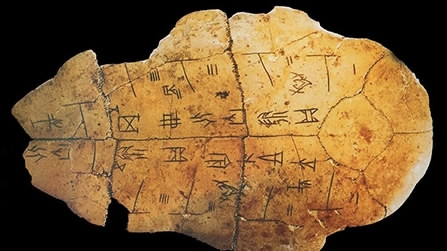The first star charts were inscribed on dragon bones by Chinese astronomers in the 14th century B.C.E. Actually, the bones were ox shoulder blades or tortoise shells. They were called Oracle Bones or Dragon Bones because diviners or fortune tellers would carve star patterns or symbols, then crack the bones with a hot poker. The cracks would be interpreted to tell the future.
NASA astronomers used fourteenth-century B.C.E oracle bones to help determine how much the earth’s rotation is slowing down. Based on analysis of the tortoiseshell inscriptions, astronomers at the Jet Propulsion Laboratory at Pasadena reported they had fixed the exact date and path of a solar eclipse seen in China in 1302 B.C.E. This allowed them to determine that the length of a day is getting longer.
Our constellation names are of Greek origin, so we tend to think of the Greeks being the first astronomers. However ancient Chinese observers of the night sky were keeping astronomical records long before the Greeks. Most of the Chinese patterns or constellations were entirely different than those recognized by the Greeks. Of all the thousands of star patterns about a dozen were seen in the same way by both Chinese and Western astronomy. Great Bear and Orion; Auriga, Corona Australis, and Southern Cross.
The Greeks may have given us our modern nomenclature for the night sky, however the Chinese provided the way in which we reckon the precise positions of the stars. The Chinese invented the system used by astronomers today to precisely pinpoint a star’s location with Right Ascension and Declination. Your Name a Star certificate displays these same coordinates, so you can find your star in the heavens.
The famous Halley’s Comet is named after an English astronomer who predicted the next return of the comet in 1758 CE, yet the Chinese first recorded the comet over 2,000 years earlier in 467 B.C.E. Modern astronomers have used ancient Chinese astronomy records to track comets and the birth of stars. Chinese astronomers even built the world’s first clock 600 years before the first Western clock.
From dragon bones to clocks, ancient Chinese astronomers played a key role in laying the foundation for modern skywatching and getting to work on time.

